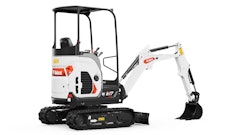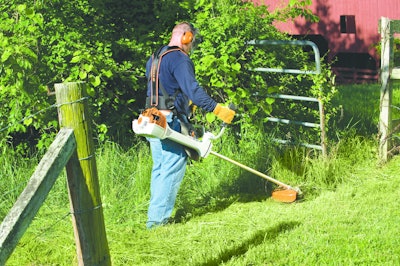
As important as string trimmers and lawnmowers are to a landscape maintenance contractor's operation, they do have their limitations. Brushcutting equipment—be it a handheld or walk-behind unit, or even an attachment for a skid steer, tractor or mower—allows equipment operators to take on more work.
Land-clearing operations are a great example (check out this story). Conditions are tough with heavy growth and oftentimes arduous terrain. Brushcutting equipment also makes a lot of sense in many landscape maintenance settings where operators are not maintaining certain areas on a regular basis.
This is why brushcutting equipment appeals to many different types of operators, including landscape contractors. "Our primary customers are rental companies, departments of transportation, and landscape professionals," says Morgan Harkness with Canycom USA, a distributor of walk-behind and ride-on brushcutters based in Bellevue, WA.
Minnesota-based Jari USA, whose walk-behind sickle mower is among the most popular products on greenindustrypros.com, says it has had success selling to hobby farmers, nurseries, parks departments, municipalities, military bases and golf courses.
Stihl's vast lineup of handheld power equipment includes three models of heavy-duty brushcutters/clearing saws: the FS 360 C-E, 460 C-EM and 560 C-EM. "These units are mainly being used to cut overgrowth in areas that are not cut on a regular basis," says Marv Mathwig, Stihl's product manager for power tools. "We're talking about ditches, banks, roadsides and hillsides with difficult terrain and hard-to-reach, sloped areas that are not easily accessible for a vehicular cutter like a brush hog."
That said, Stihl dealers are primarily selling handheld brushcutters/clearing saws to government entities, farmers and forestry-type silviculture contractors. Landscape contractors represent about 5% of brushcutter/clearing saw sales. "But do not discount the landscaper," Mathwig is quick to point out. "Many landscapers do have a need for a brushcutter, and that need could increase as more government entities look to privatize at least some of their groundskeeping tasks."
Growing need for landscape contractors
Potential government contract work aside, many landscapers are already finding a need for brushcutting equipment. "On properties where the landscaper is trying to do some work on more remote terrain, they are using brushcutters/clearing saws because they are not maintaining those areas on a frequent basis," Mathwig explains. "An example would be hillsides which are only trimmed every couple of months."
Scott Heseltine, sales manager for North Carolina-based PECO, says landscape contractors are showing a growing need to reclaim and maintain retention ponds in both residential and commercial settings, which include condo complexes, homeowner associations and corporate campuses. PECO's newly redesigned TBB-3002 Brush Blazer has proven to be a good fit in these applications.
"Landscapers are finding a niche and are expanding their businesses into this area," Heseltine says. "Retention pond management is becoming a big issue in states that have passed laws saying that the ponds have to be maintained. But you can't put heavy equipment in those areas. Handheld brushcutters will work, but aren't that efficient. A walk-behind unit like our Brush Blazer can help reduce labor time by 70%."
Landscape contractors have actually become the primary buyers of PECO's Brush Blazer. "We're also selling machines to government and military accounts, along with park systems that are using the machines for trail maintenance and right-of-way clearing," Heseltine adds.
Making the right choice
Whether the operator should opt for a handheld brushcutter/clearing saw or walk-behind machine really comes down to utilization. A walk-behind unit is obviously a lot more machine, and thus, more expensive. But if it will be put to good use on a frequent basis, it might make the most sense from an ROI standpoint. Remember, one of the best things a landscape contractor can do is find equipment that helps reduce labor needs.
Another thing users should keep in mind is that they should not use metal cutting attachments in at-risk fire areas with rocky terrain, according to Stihl. The area should be inspected prior to cutting to help avoid striking rocks and other foreign debris. Users should then follow their instruction manual for the piece of equipment they are operating.
Equipment dealers can help landscape contractors select the right piece of brushcutting equipment. Stihl has thousands of servicing dealers throughout the country. PECO is in the process of building up its nationwide dealer network. Mason’s Saw & Lawnmower Service in El Cajon, CA, is one dealer that sells both Stihl and PECO equipment.
"Mason's Saw is a great dealer that understands that in order to sell a unique product like our walk-behind Brush Blazer, you have to get out there and demo the machine for contractors," Heseltine says. "If a dealer is willing to get out there and get his hands dirty demoing, he can have success with a product like this."
And for landscape contractors who need to get their hands dirty trimming heavier growth in areas their normal string trimmers and lawnmowers can't handle, they can have some success with brushcutting equipment too.


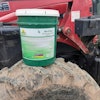
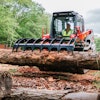

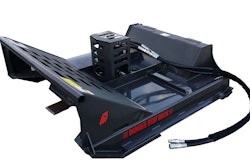
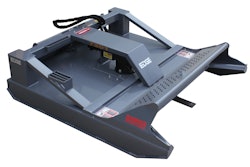
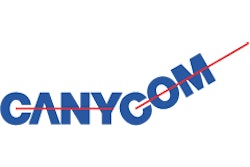
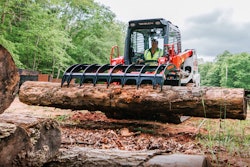

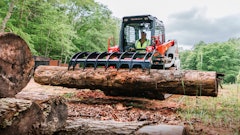





![Doosan Bobcat Wacker Neuson Stack 2ec Js Pb V6e[1]](https://img.greenindustrypros.com/mindful/acbm/workspaces/default/uploads/2025/12/doosan-bobcat-wacker-neuson-stack2ecjspbv6e1.CPyyz8ubHn.png?ar=16%3A9&auto=format%2Ccompress&bg=fff&fill-color=fff&fit=fill&h=135&q=70&w=240)




